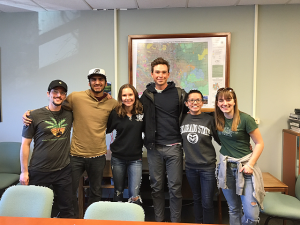By George Simpson
Ecosystem Science and Sustainability is one of the majors offered through Colorado State’s Warner College of Natural Resources. The degree program teaches students how to better manage the Earth’s natural resources through the application of science in decision and policy making areas. After four years in the program, many students are finishing their final semester and preparing to graduate. For most, this means enrolment in the curriculum’s capstone class ESS 440. The distinguishing feature of the class is a semester long project working with a local agency. The projects are designed to allow students to apply the skills they have been carefully refining over the past four years in order to help practitioners solve a local sustainability problem. Student have multiple project choices to choose from, and thus are divided into smaller teams to work in throughout the semester.
Our team will be collaborating with the Colorado Natural Heritage Program (CNHP) throughout this semester. The Colorado Natural Heritage Program works with rare and imperiled species in Colorado, conducting research and sharing their expert information with stakeholders in order to help ensure that Colorado’s biodiversity is not diminished. CNHP has mapped over 1,800 Potential Conservation Areas (PCAs) in the state that contain species of biodiversity significance. Our team will be running an analysis of their PCAs to determine what areas in Colorado have experienced the greatest impacts from anthropogenic disturbances. This information will allow us to prioritize conservation efforts by combining knowledge about the biodiversity these areas contain, and the level of disturbance the area has experienced from anthropogenic activities. Included with this assessment, the team will create a summary of its findings to be shared with the general public.
While a seemingly complex task such as this may appear daunting at first glance, 2017’s ESS 440 CNHP project team has fielded some real talent, fully qualified to complete the task at hand. Aspiring young scientists Julia, Alex, Daniel, Caden, Leo and George, working under the guidance of CNHP’s Michelle Fink and David Anderson, will use this semester to better understand the sources of anthropogenic disturbance in Colorado. The team’s composition has allowed us to blend technical expertise and creativity skills to best complete this project.
 |
| The ESS 440 project team from left to right: Leo, Caden, Danielle, George, Julia, and Alex. |
Alex and Julia are the team’s ArcGIS wizards. They cast virtual ArcGIS spells to extract, clip, interpolate, overlay and buffer CNHP’s data so that it can be grown into a map that tells the story of anthropogenic disturbance in Colorado. Their work will produce a map of Colorado depicting potential conservation areas in the state and the extent to which they are affected by a number human activities.
The next step in the team’s analysis will be to pick apart the results, identifying overlying trends and drivers of anthropogenic disturbances. Danielle and George will pore over the results, looking for spatial patterns and reoccurring themes between sites. The two will compile the team’s work into a digestible, easy readin’ scientific report that details the project’s goals, methods, results, and outcomes.
The team’s final members, Caden and Leo, are in charge of crafting the projects final piece, a summary of our work designed to be shared with the general public. They will shape the project’s key points into an interactive story of the project that people can access to learn more about this project and the work that CNHP does.
As the semester winds down, stay tuned for our team’s completed project and access to our Storymap that you can use to learn about sources of anthropogenic disturbance that affect outdoor areas in Colorado near you.




